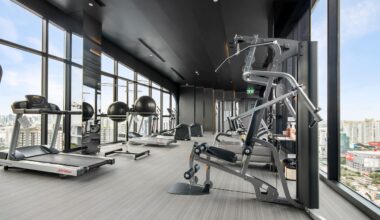Combining Sandbags and Bodyweight Training
Combining sandbags and bodyweight training offers a unique approach to fitness that enhances strength, endurance, and stability. Sandbags provide an unstable load that forces your muscles to engage more deeply, improving balance and coordination. When utilized alongside bodyweight exercises, they create a dynamic workout regime that targets multiple muscle groups simultaneously. Whether you are a beginner or an experienced athlete, the versatility of sandbags allows customization of the workout. For beginners, start with light sandbags focusing on form and technique throughout bodyweight exercises. Once comfortable, gradually increase weight. An intermediate person can alternate between push-ups, squats, and sandbag carries. For advanced practitioners, combining movements, such as burpees with a sandbag toss, provides an intense challenge. To make the most of sandbag training, integrate it into your existing routine. Aim for 2-3 sessions per week where you alternate between bodyweight exercises and sandbag drills, ensuring sufficient rest. This approach will contribute to a well-rounded fitness regimen that promotes muscle development and functional strength. Consider tracking your progress by recording the number of repetitions and sets to monitor improvements over time.
Benefits of Sandbag Training
The incorporation of sandbag training into your fitness routine reaps an array of benefits. Firstly, it enhances strength development as lifting and moving the sandbag requires proper engagement from various muscle groups. This full-body workout not only builds muscular endurance but also boosts overall athletic performance. Secondly, utilizing a sandbag adds an element of instability, which forces core muscles to engage more significantly compared to traditional weights. This helps improve core strength and stability, essential for functional movements. Another impressive advantage is injury prevention; working with uneven loads develops proprioception, enhancing your movement awareness. Moreover, sandbags are portable and versatile. They can be adjusted for various exercises such as carries, squats, and presses, allowing you to take your workout anywhere. Adjusting the grain quantity inside the bag can also modify the weight easily, making the equipment suitable for all fitness levels. Besides physical strength, sandbag workouts promote mental toughness and resilience, pushing you through challenging workouts. Lastly, pairing sandbags with bodyweight exercises is fun, inventive, and effective, keeping your workouts engaging while continuously providing growth and adaptability for your training goals.
To maximize the effectiveness of sandbags in your workout, understanding how to safely use the equipment is essential. Begin with proper warm-up exercises to prepare your muscles and reduce the risk of injury. Techniques such as dynamic stretches or foam rolling can prepare your body for an effective session. When lifting sandbags, position yourself efficiently to maintain balance and control the load. Start with the bag on your knees or from a deadlift position for safety. Grip the handles correctly; often, this requires ensuring a firm grasp to avoid slips during exercises. As you engage in bodyweight movements, synchronize your breath. Inhale during the easier segment and exhale as you exert force, like during sandbag lifts or when pushing away during a push-up. After your workout, prioritize cool-down sessions, stretching the specifically targeted muscle groups. Incorporating both sandbag and bodyweight exercises develops a strong foundation for overall fitness and contributes to muscle recovery. Consider classes or local fitness groups focusing on sandbag training to learn correct form techniques from certified trainers for further safety and effectiveness. Ensure consistency in your training for long-term success and pay attention to your body’s feedback throughout your workouts.
Creating a Balanced Workout Plan
When incorporating sandbags and bodyweight exercises into a balanced workout plan, diversity is key. A typical workout might include a warm-up period, followed by alternating between sandbag drills and core body movements. Start with 5-10 minutes of light cardio such as jumping jacks or jogging in place to elevate your heart rate. Next, integrate three rounds of bodyweight exercises like push-ups or squats, performing 10-15 repetitions in each set. Follow this with a sandbag exercise, such as a overhead press, for a similar number of reps. Keeping rest intervals brief, between 30-60 seconds, maintains exertion levels, enhancing cardiovascular benefits. It’s recommended to integrate workouts with sandbag training 2-4 times weekly while alternating muscle groups to allow adequate recovery. For optimal results, track your progress over time, aiming to gradually increase weight and reps as strength levels improve. Listen to your body and adjust the intensity based on your individual fitness goals. Cycling different exercises every few weeks prevents plateaus and keeps workouts fresh and motivating. Engaging with a community or workout partner can elevate motivation and accountability, contributing significantly to your fitness journey.
Some effective sandbag exercises include carries, thrusters, and loaded lunges that can be integrated with bodyweight moves. For example, try performing a sandbag clean followed by a squat jump – this combo effectively elevates heart rate while ensuring muscle engagement throughout your entire body. Sandbag carries involve lifting the weight while walking a designated distance, focusing on core stability and back strength. Another engaging method is the bear crawl, where you carry a sandbag in a bear position for distance, challenging both upper and lower body strength simultaneously. Additionally, implementing circuits that alternate rapid-fire exercises will ensure that fatigue sets in, optimizing muscle response and training endurance. Consider setting a timer to perform each exercise for 30-60 seconds followed by minimal rest for added intensity. Cooldowns afterward might include stretches targeting the core, shoulders, and legs, ensuring recovery and muscle regeneration. Accessing quality resources like fitness channels or community apps can help you discover new workout innovations to maintain interest and efficiency. With creativity and adaptability, incorporating sandbags with bodyweight exercises allows for effective workouts promoting fun and dynamic training experiences.
Safety Considerations
While the combination of sandbags and bodyweight training is effective and engaging, safety should always be paramount to avoid injuries. Start with lighter weights, especially if you are unfamiliar with sandbag training, allowing your body to learn proper mechanics first. Understanding and using correct lifting techniques ensures that your muscles and joints are not strained during resistance-based workouts. Pay attention to form throughout every rep; improper form may lead to stress, especially in your back or knees. When performing exercises involving balance or dynamic movements, choose a stable surface to prevent slips that might cause accidents. If you recently recovered from an injury or are beginning a new fitness program, consider consulting a healthcare provider or certified trainer for guidance on suitable exercises and modifications. Staying hydrated during workouts is crucial; lack of hydration can lead to fatigue and loss of focus, contributing to injury risk. Additionally, listen to your body, understanding the difference between fatigue and pain, allowing you to recognize when to stop. Prioritizing safety and mindfulness while working out is essential for effective training and long-term lifestyle commitment to fitness.
To supplement your sandbag and bodyweight training, a nutritional balance plays a vital role in achieving your desired fitness goals. Focus on incorporating whole foods into your meals, including plenty of lean proteins, whole grains, fruits, and vegetables for muscle recovery. Consuming the right nutrients provides essential energy required for effective workouts and post-exercise recovery and progresses in muscle gains. Meal planning or preparing healthy snacks before workouts can help manage energy levels throughout your training sessions. Planning pre-workout meals approximately 30-60 minutes before exercising maximizes energy levels without weighed-down feelings. Furthermore, hydration should not be overlooked; aim for sufficient water intake during and after workouts to remain hydrated. Supplements may be beneficial for those looking to achieve specific goals, however, consult a nutritionist or health professional before integrating them into your routine. Lastly, maintaining a consistent sleep pattern ensures optimal recovery alongside physical training. Quality sleep aids muscle growth and repair, impacting performance significantly. Maintaining consistency across workouts, nutrition, and sleep promotes overall well-being, long-term fitness results, and readiness to tackle workout challenges that arise throughout your fitness journey.
Final Thoughts
In conclusion, amalgamating sandbags and bodyweight training yields numerous benefits enhancing overall fitness levels. The versatility and adaptability of sandbags in conjunction with bodyweight movements promote strength, balance, and stability required in various physical activities while providing enjoyable workouts. Incorporating these methods can cultivate muscle emphasis and alleviate the monotony of traditional weight training routines. Safe techniques, customizing your workouts, and integrating new exercises allow exploration of your fitness potential while staying engaged. Coupling effective nutrition and rest with workouts is paramount in fostering consistent progression toward fitness goals. Ultimately, consider joining community fitness programs or engaging with online resources focusing on sandbag training for additional motivation and accountability. Always remember your fitness journey should be enjoyable and suited to your preferences and lifestyle, making it easier to stay committed long-term. As you combine these techniques, embrace the process of learning and understanding what works best for you as you shape your athletic approach. Through commitment and dedication over time, the combination of sandbags and bodyweight training can lead to admirably improved physical strength, endurance, and overall health.


